Dean Jacobs can describe the world of welding equipment in two words: bolt-on. “People bolt on this subsystem here, bolt on that one there,” says Jacobs, Principal Automation Engineer at LJ Welding Automation. “Soon, your welding cell has seven control panels and needs a massive power bar to feed them all.” The bolt-on approach was born of necessity. However, as technologies advance and equipment end users demand more modular solutions, the design and maintenance of such systems has become unsustainable.
LJ Welding Automation recognized early on that an integrated approach not only provides a cleaner look, but also a key differentiator for machines in a bolt-on world. The Edmonton, Alberta-based company provides wide-ranging solutions, specializing in submerged-arc welding manipulators. With customers in more than 50 countries, it serves industries as diverse as oil and gas, alternative energy, aerospace, transportation, infrastructure, healthcare and beyond.
“When my partners and I bought the company in 2006, it made just six widgets, but it had a great customer base,” VP of Product Development Tim Robinson says. “We took a chance and turned it into an engineering company. Over the last 17 years, we have expanded rapidly, and now we have hundreds of products as well as many custom, application-specific solutions. We can also tie together multiple pieces of equipment and provide complete turnkey plant design.”
With the new Pipe Titan pipe welding system, LJ Welding Automation offers a complete pipe processing center. The system is optimized for 2- to 24-inch-diameter pipes. One of the first Pipe Titan systems needed to deliver high-performance pipe welding at the Cleaver-Brooks facility in Stratford, Ontario. EtherCAT and PC-based control technologies from Beckhoff helped consolidate functionality into a centralized control architecture and provide a flexible, fully integrated solution.

The Pipe Titan pipe welding system from LJ Welding Automation is a turnkey pipe processing center optimized for 2- to 24-inch-diameter pipes.
Optimized welding is not just a pipe dream
Cleaver-Brooks is a global provider of efficient boiler room solutions, with a focus on reducing energy usage, cost and environmental impact. The pioneer of packaged firetube and watertube boilers stands alone in offering an entirely integrated boiler room solution for applications of any size. Cleaver-Brooks had several requirements for Pipe Titan, including reducing costs, improving quality, increasing productivity and enhancing safety, according to Corporate Welding Specialist Joel McLeod.
“Welding is a core competency at Cleaver-Brooks that helps ensure the structural integrity and reliability of our boiler room products and systems,” McLeod explains. “We use a variety of welding processes throughout production to assemble and join various metal components in order to create sturdy and leak-proof boiler systems.”

Cleaver-Brooks manufactures efficient boiler room solutions, with a focus on reducing energy usage, cost and environmental impact.
In addition, the LJ Welding Automation engineering team needed to maintain a clean design with highly deterministic control and system modularity for changing production processes. They also needed automation and networking technologies to support a high-end welder from EWM, according to Jacobs. This welding equipment uses highly tailored programs to limit heat in the workpiece, thus minimizing warping and corrosion in pressure piping. The new welder had to work with the existing recipe management system to guarantee reliable and consistent results.
PC-based control sparks innovation
As he has done before, Jacobs turned to Beckhoff to meet the Pipe Titan project’s challenges. “When I started at LJ a decade ago, it was a blank slate in terms of automation platforms,” he says. “A major draw of PC-based control was – and continues to be – the ability to integrate third-party technologies on one platform. I was blown away by the technology as well as the service from Beckhoff Canada back then, and a complete solution cost less than just the HMI and controller hardware did from our legacy PLC vendor. We have continued to use Beckhoff on our machines ever since.”
What's the difference between PC and PLC controls?
Get your free white paper debunking misconceptions about PC-based control vs PLC.
The Pipe Titan uses a CP6700 “economy” built-in Panel PC as the central machine controller. Combining HMI and control CPU in one device, the CP6700 offers a 10-inch touchscreen with Intel Atom® processors. The Pipe Titan has two separate positioners, and each has its own CX series embedded controller from Beckhoff. “The positioners have their own controller for simple one- or two-axis P2P applications to rotate the pipe, along with functional safety and an HMI server. This way, they can function as independent machines if needed,” Jacobs says. “You can unplug one positioner, take it to the other side of the plant, and use it. We use this modular architecture on all our larger machines.”
TwinCAT 3 automation software enables this architecture as an end-to-end engineering and runtime environment. Rather than the bolt-on approach of many black-box machine control offerings, TwinCAT combines all functionality on a comprehensive platform for everything from PLC, HMI and motion control to IoT, analytics and even machine learning.TwinCAT supports programming in all IEC 61131-3 languages and their object-oriented extensions, custom or predefined function blocks, and computer science standards in Microsoft Visual Studio®. LJ Welding Automation leverages Structured Text, JavaScript for HMI development and other languages as necessary. TwinCAT helps the LJ Welding Automation engineering team consolidate to a single tool chain to avoid switching between development environments. It also provides them with advanced source control options, as Benjamin Vandenberg, Automation Engineering EIT at LJ Welding Automation, explains.
“A standout feature of TwinCAT is the excellent integration of source control, especially with all of the custom work we do. This prevents confusion – and space requirements for – unnecessary copies of projects with different dates. The license-free development environment means our team can log in on their own laptops without issues,” Vandenberg says. “Also, TwinCAT Library Manager speeds up development by allowing us to add or remove large blocks of code instead of writing it from scratch. We can save any changes to the source control to easily fix bugs, update the library and continue to pursue continuous improvement of our products.”
EtherCAT brings together speed and flexibility
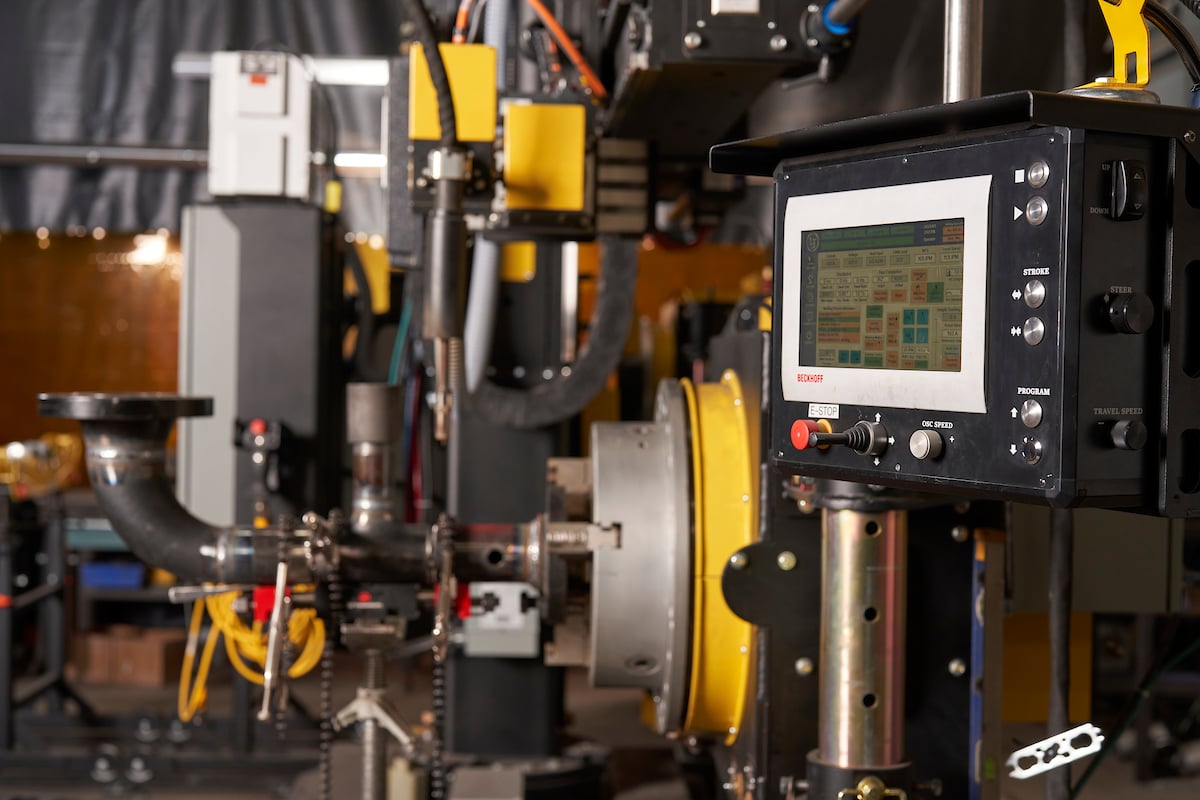
CP6700 Panel PC from Beckhoff
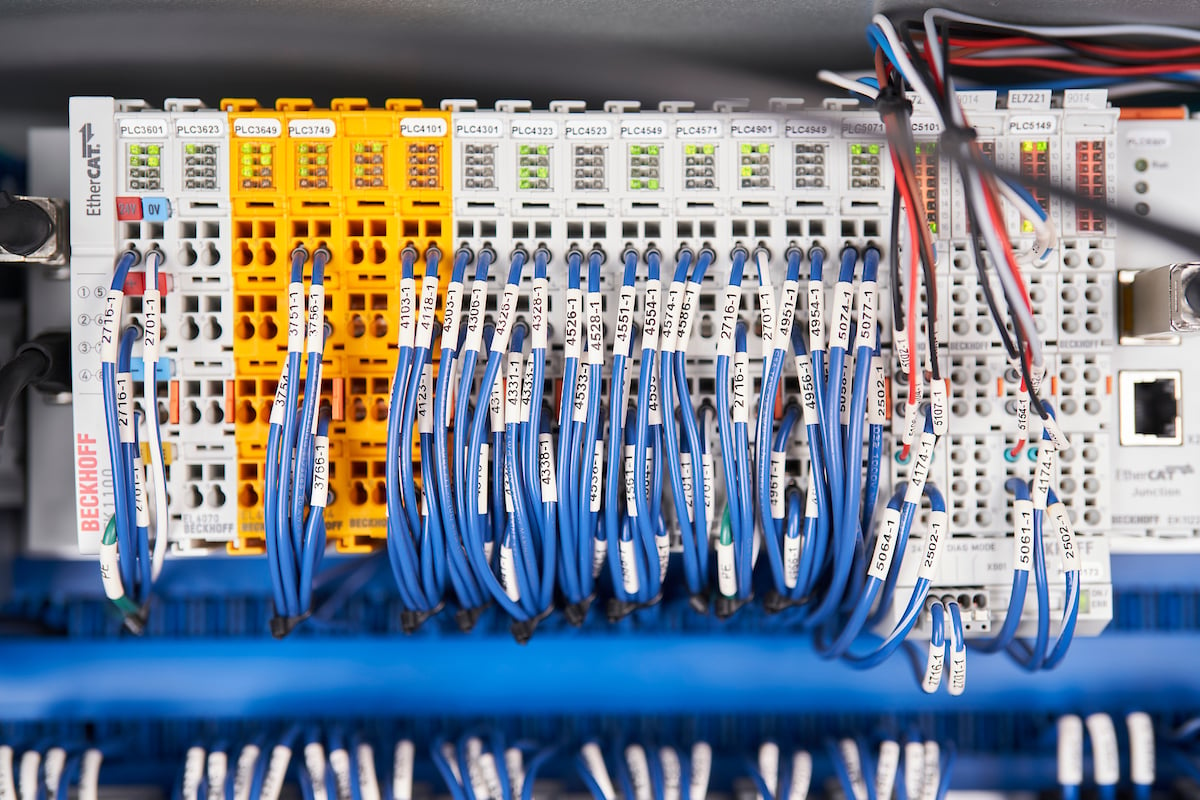
EtherCAT and TwinSAFE modules
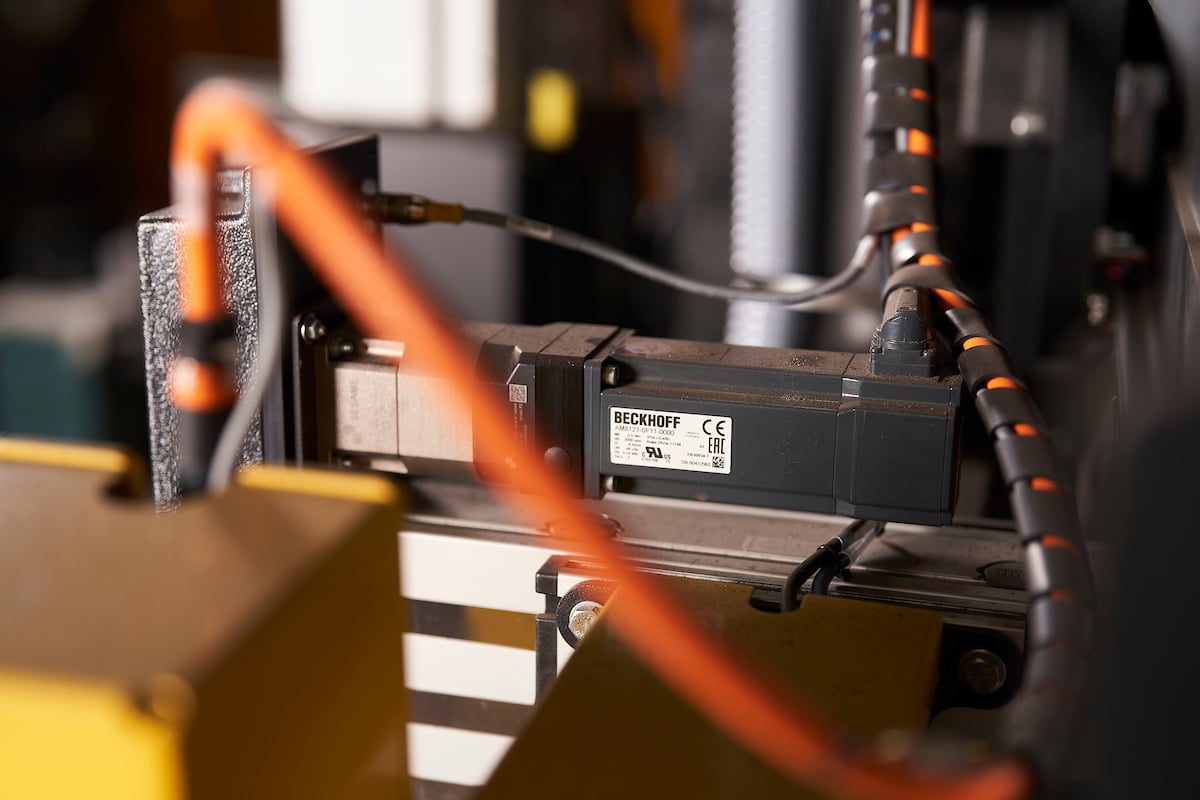
A Beckhoff AM8100 servomotor
The EtherCAT industrial Ethernet system’s flexibility and scalability proved instrumental to the integrated yet modular design. EtherCAT enables free selection of topology, up to 65,535 nodes on one network and hot connect capabilities. For the positioner modules, the Pipe Titan uses EtherCAT Automation Protocol (EAP) for controller-to-controller communication and safety.
The Pipe Titan has multiple E-stops across its modules, which communicate via TwinSAFE, the integrated functional safety solution from Beckhoff. TwinSAFE works over the standard EtherCAT network using a “black channel” approach. As such, it supports modular machine designs without any hardwired safety controllers to physically adjust, Vandenberg explains: “We essentially have three independent safety systems running, each one with an EL6910 TwinSAFE Logic Terminal. They communicate to each other using Safety over EtherCAT (FSoE), and we can simply turn those connections on and off in software using TwinSAFE features. We can add or remove different pieces of equipment as necessary to make it a more adaptable and scalable system.”
The LJ Welding Automation engineering team also relies on the vast number of available EtherCAT I/O terminals. The EL7211 and EL7221 servomotor terminals provide a compact motion interface in the 48 V range to AM8100 series servomotors. The EL3255 5-channel potentiometer modules ensure accurate speeds on the positioners when controlled by a hand pendant, variable-speed foot pedal, etc. The high conformance standards of the EtherCAT Technology Group ensure third-party devices, such as a VFD on the Pipe Titan, work seamlessly with the EtherCAT controllers from Beckhoff.
EtherCAT also supports connection to more than 30 communication protocols with the simple addition of a gateway. This promotes greater flexibility in component selection and avoids bolt-on scenarios. “On the Pipe Titan, the EL6224 IO-Link master terminal was particularly useful for connecting a laser displacement sensor, and we’ve used it in many other applications,” Jacobs says. “IO-Link is a flexible technology to connect sensors and other devices. The nodes can be inputs or outputs, so I don't have to stock numerous analog cards. The ability to bring the IO-Link devices into an EtherCAT network with a compact bus terminal adds greater flexibility to the system.”
Automated welding system delivers seamless results
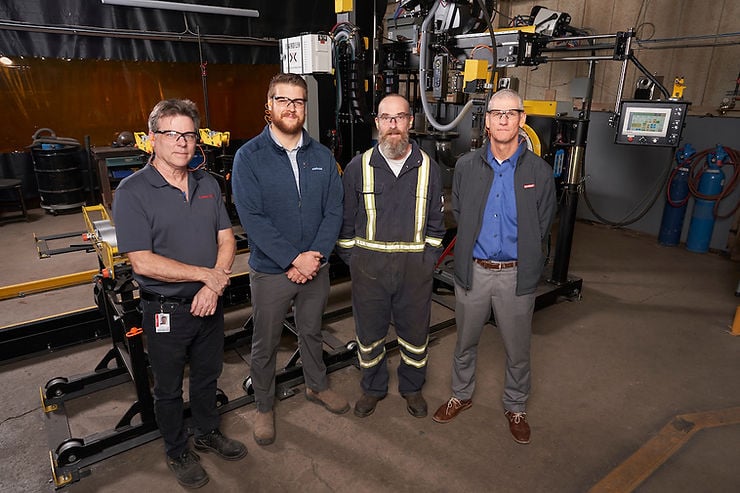
At the Cleaver-Brooks site in Stratford, Ontario: (from left) Plant Engineer Dan Strangway, Corporate Welding Specialist Joel McLeod and Welder Shane Elder of Cleaver-Brooks meet with Dean Herron, Regional Sales Engineer at Beckhoff Canada.
By leveraging PC-based automation from Beckhoff, the team at LJ Welding Automation implemented a system that surpassed the requirements of Cleaver-Brooks. The Pipe Titan led to impressive performance increases, according to McLeod. Cleaver-Brooks reduced arc time by 63% on average, which is nearly three times faster. The Pipe Titan also led to a 90% reduction in weld clean up time, 10% reduction in rework and 39% reduction in filler metal spend.
“The Pipe Titan welding system allows us to perform tasks faster and more efficiently than manual labor, leading to increased productivity and capacity. It reduces errors and inconsistencies, resulting in higher quality output,” McLeod says. “Being mechanized, it can be programmed to perform a variety of tasks and can be easily reconfigured to meet our changing production demands. The Pipe Titan welding system helps reduce the risk of workplace accidents and injuries associated with manual labor, thereby improving employee safety.”
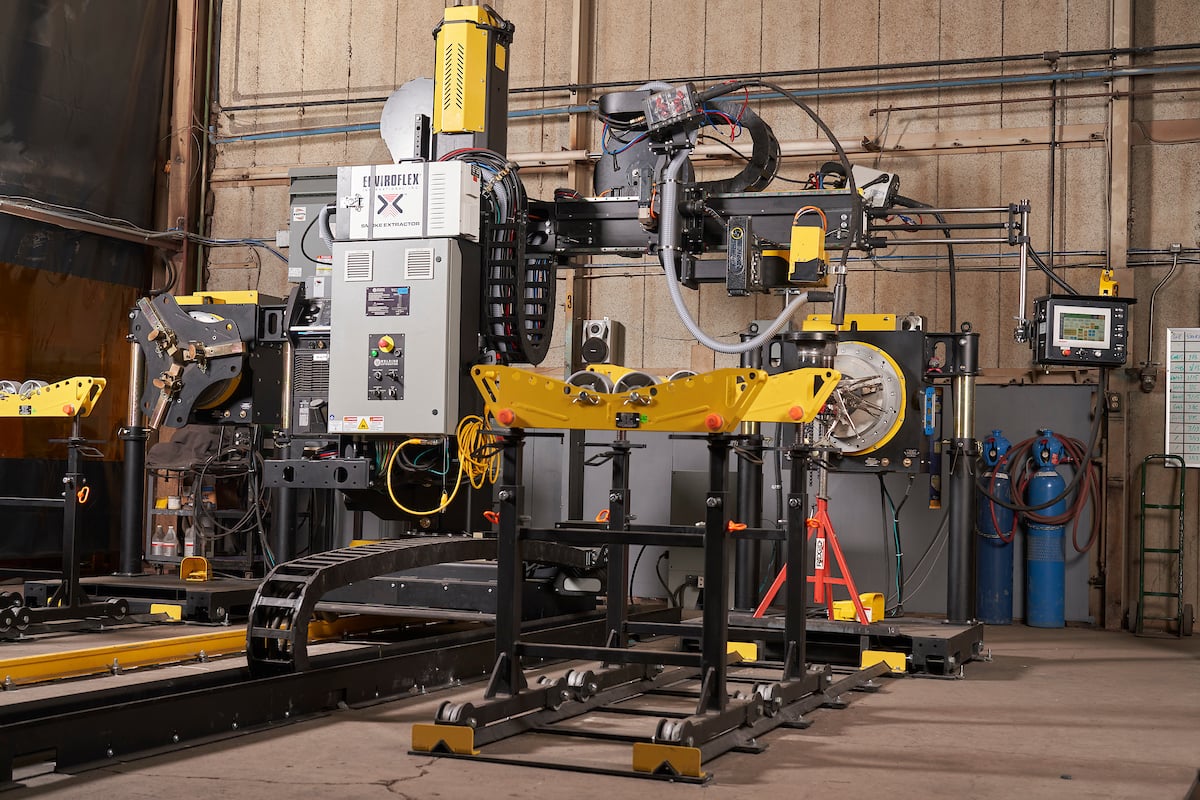
A Pipe Titan at Cleaver-Brooks
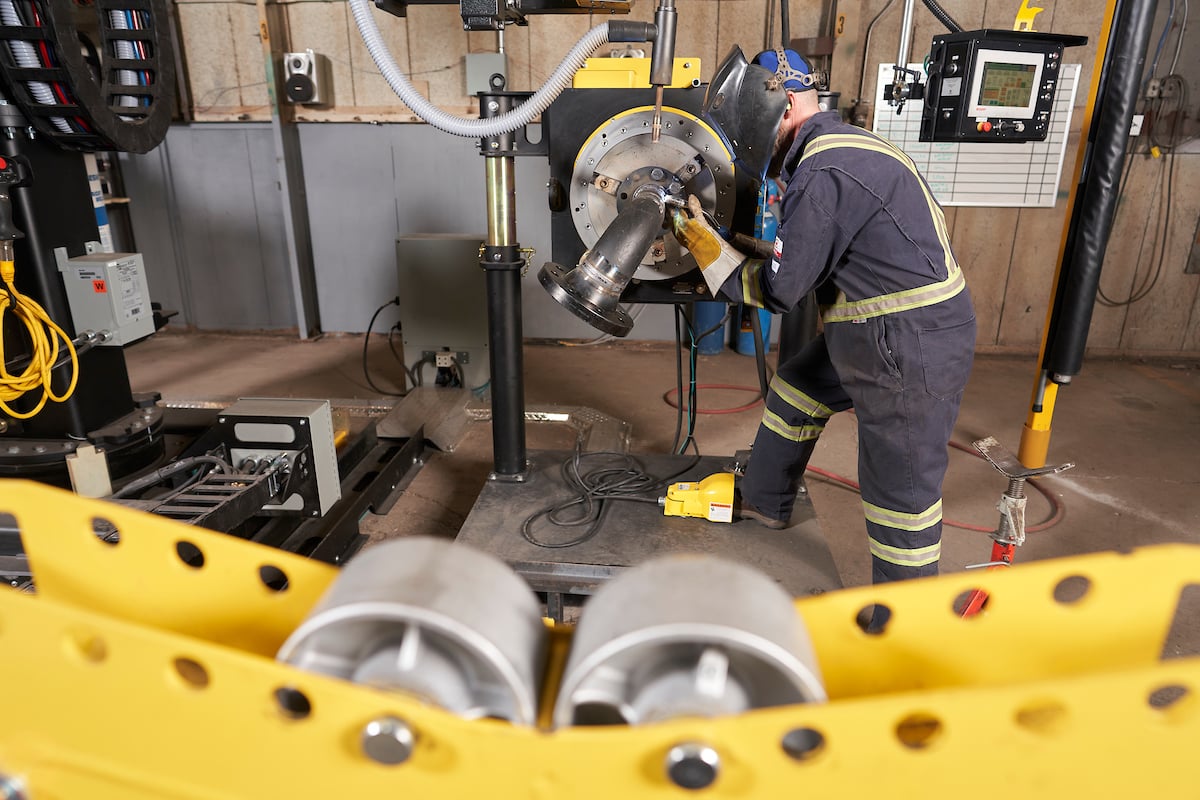
Welding is a core competency
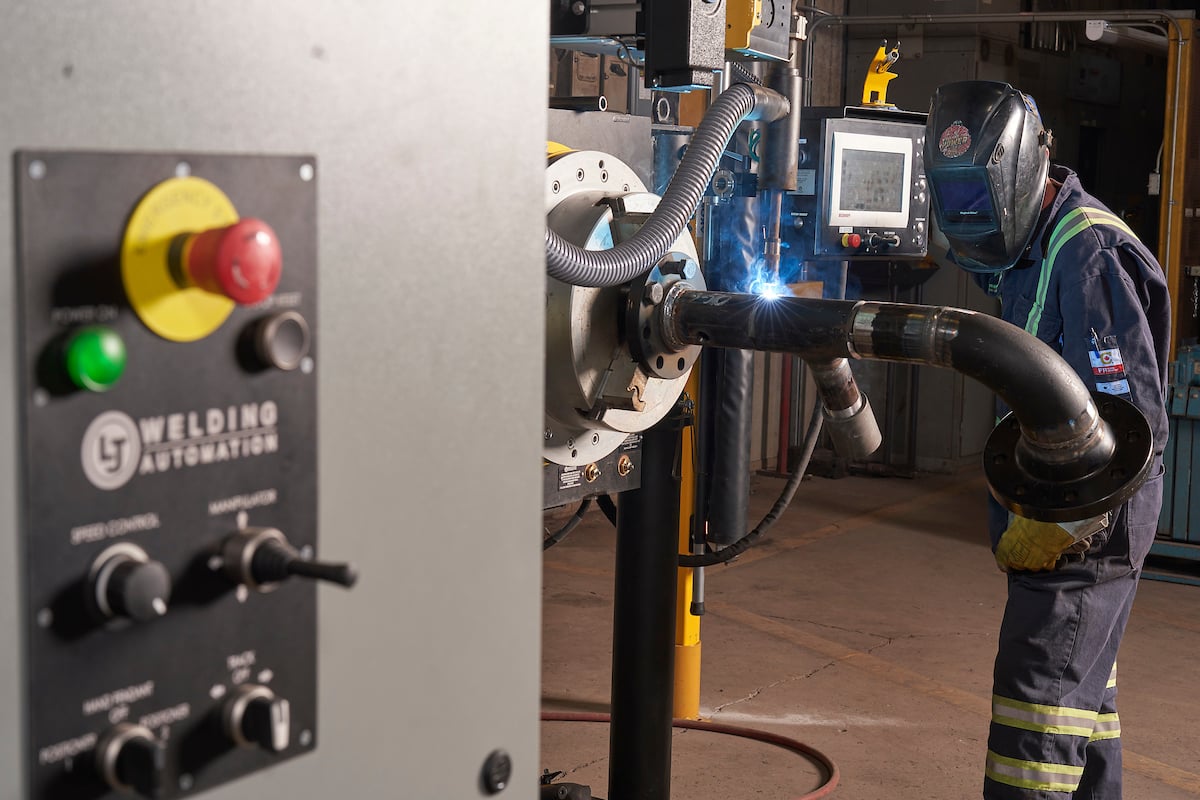
Robotics boosted welding speed
TwinCAT accelerated development, and the built-in software oscilloscope, TwinCAT Scope, enhanced tuning of the machine. EtherCAT enabled commissioning of the machine from a single Ethernet cable through mailboxes that Vandenberg set up. Beckhoff servo technologies saved space through compact drive offerings and One Cable Technology (OCT). Using the IPC Security Guideline from Beckhoff, LJ Welding Automation can safely remote into customer machines for maintenance or troubleshooting. But the team isn’t stopping there.
The next phase for the Pipe Titan and other LJ Welding Automation machines is higher-level connectivity for analytics and continuous improvement, according to Robinson. “For customers with half a dozen machines or more, IoT functionality is important for managing and optimizing analytics and training new employees,” he says. “Having an analytics suite that works together in a central dashboard will be huge for those customers.”
Fortunately, for Jacobs, this is another area where Beckhoff’s technology is not bolt-on. Standard analytics algorithms, no-code dashboards, secure connectivity via OPC UA and more are all built into TwinCAT. The flexibility of the full-system solution continues to help LJ Welding Automation offer unique, highly differentiated solutions to the market. “We strive not to paint ourselves into a corner, because we often have to make changes late in the game,” Jacobs says. “With PC-based automation from Beckhoff, we have been able to make continuous improvements over the years. It has been a robust platform for us, and we're not even close to outgrowing it.”
.png?width=76&height=76&name=Untitled%20(100%20x%20100%20px).png)
.png?width=550&height=275&name=You%20may%20also%20like%20(2).png)
.png?width=550&height=275&name=You%20may%20also%20like%20(1).png)
